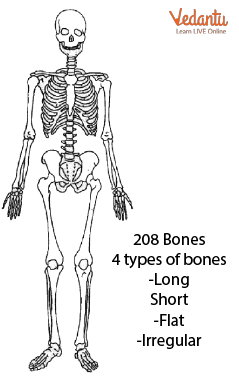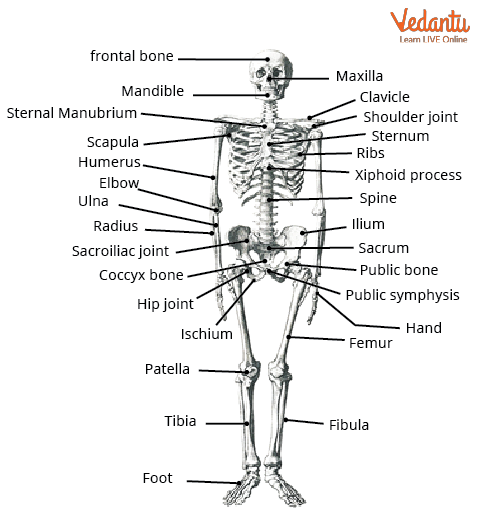




Introduction to Skeletal System for Kids
For body movements such as running, swimming, jumping and climbing, we need the help of our bones and muscles. All the bones in our body together form the skeleton system. Our bodies contain 206 bones. Another name for it is the musculoskeletal system. Bone makes up the majority of the skeletons in vertebrates. Each type of animal has a different skeletal structure made up of bones.
Our skeletal system gives our body stability and strength so that we don't just flop around like jellyfish, and also protects our organs. For instance, the rib cage and skull both shield our heart and lungs from harm. Other bones, such as those in our arms and legs, support our muscles and allow us to move around.
Skeletal Types
Fish, amphibians, reptiles, birds, and mammals all have skeletal systems. There are also animals which do not have skeletons inside their bodies such as insects or shellfish. Instead, they have exoskeletons, which are tough external coverings. Coral and sponge skeletons are composed of stony minerals rather than bone. Some creatures, like jellyfish, don't even have skeletons.
On the basis of this, there are two main categories of skeletons - solid and fluid. Solid skeletons can have an exoskeleton (which is external) or an endoskeleton (which is internal), and they can also be pliable (which is elastic and mobile) or rigid (which is hard and immovable). Fluid skeletons are always internal.
1. Exoskeleton
Many invertebrates, including arthropods and molluscs (snails), have external skeletons called exoskeletons that enclose and protect the body's delicate tissues and organs. As an animal grows, several exoskeleton types undergo periodic moulting or ecdysis.
This is the case for many arthropods, such as insects and crustaceans. In addition to providing protection, insects' exoskeletons also operate as a surface for muscle attachment, a waterproof barrier against drying, and a sensory organ for communication.
2. Endoskeleton
Animals have an internal support system called an endoskeleton, which is often seen in vertebrates and is made of mineralized tissue. The role of endoskeletons can range from being solely supportive to acting as a point of attachment for muscles and a means of transmitting muscular forces. Mesodermal tissue serves as the foundation for a real endoskeleton. Echinoderms and chordates both have this type of skeleton.
3. Pliant Skeletons
Since flexible skeletons can move, when skeletal tension is applied, they can deform before regaining their original shape. Some invertebrates utilise this skeletal structure, such as the hinge on bivalve shells and the mesoglea in cnidarians like jellyfish.
4. Rigid Skeletons
Strong support systems are more prevalent in terrestrial animals because rigid skeletons cannot shift under stress. This sort of skeleton is more protective or employed by animals that move quickly and need extra support for their muscles to swim through water.
Human Body Skeleton
The internal skeleton that supports the human body is called the human skeleton. This framework is made up of numerous separate bones and cartilages. In close contact with the components of the skeleton are bands of fibrous connective tissue as well as ligaments and tendons.
Similar to other vertebrates, humans have two main subdivisions of the skeleton, each of which has a unique origin and unique characteristics. They are axial, which includes the vertebral column, the spine, and a large portion of the skull, and the appendicular, which includes the pelvic (hip), pectoral (shoulder), and limb bones and cartilage.

Skeleton Body of Human
Skeleton and Bones
Typically, the adult human skeleton has 206 named bones. The vertical axis of the body is formed by the 80 bones of the axial skeleton. The free appendages and their connections to the axial skeleton are part of the 126-bone appendicular skeleton. The top and bottom extremities, often known as limbs, with their girdle-like linkages make up the free appendages.
Physiology of the Skeletal System
The skeletal system's main purposes include movement, support, defence, blood cell creation, mineral storage, and endocrine regulation.
1. Support
The skeletal system's main purpose is to give the body and its organs a sturdy framework for support and protection. This aids in preserving the general human body shape.
2. Protection
By serving as a cushion, the skeletal system also contributes to the protection of our delicate interior organs and other bodily structures, such as the brain, heart, and spinal cord. The ribs protect our heart and lungs, the vertebrae protect our spinal cord, and our cranium (skull) protects our brain and eyes.
3. Movement
Bones offer the fundamental framework for muscles to adhere to our bodies to move.

Human Skeletal System With Labelling
Summary
The skeleton system offers a structure that supports and shields the body's organs, thanks to its moving joints. This web of bones is active and interacting with other bodily systems, far from being dry or dead. Deep inside the bones, in the bone marrow, millions of brand-new blood cells are produced every second. Muscle and bone are connected by sturdy cables. Bones can move when muscles pull them.
FAQs on Skeletal System
1. How is the skeletal system connected?
The skeleton's bones are held together by tough, leathery coverings called ligaments. Some of the bones are also held together by muscles. But the majority of the time, muscles are joined to bones by a cord known as a tendon. Cartilage serves as a protective coating for the joints where bones join. Without this coating, two hard bones would wear down and suffer harm if they were to rub against each other repeatedly. While still being elastic enough to prevent damage to itself, cartilage is strong enough to shield the bones.
2. What purposes do bones serve?
The body is shaped by its bones. The brain, heart, lungs, and other internal organs are protected by bones. Bones support the body and firmly place muscles. Minerals such as calcium and phosphate are stored in bones. Bones facilitate movement of the body. Red blood cells are produced in the bones. When the body requires energy, certain types of bones release the fat they have stored. Organs are protected by the bones from blows, piercings, and other types of external harm.
3. What does the axial skeleton consist of?
The skeletal elements that are present along the longitudinal axis of the body. It consists of the skull, vertebral column, ribs and sternum.









